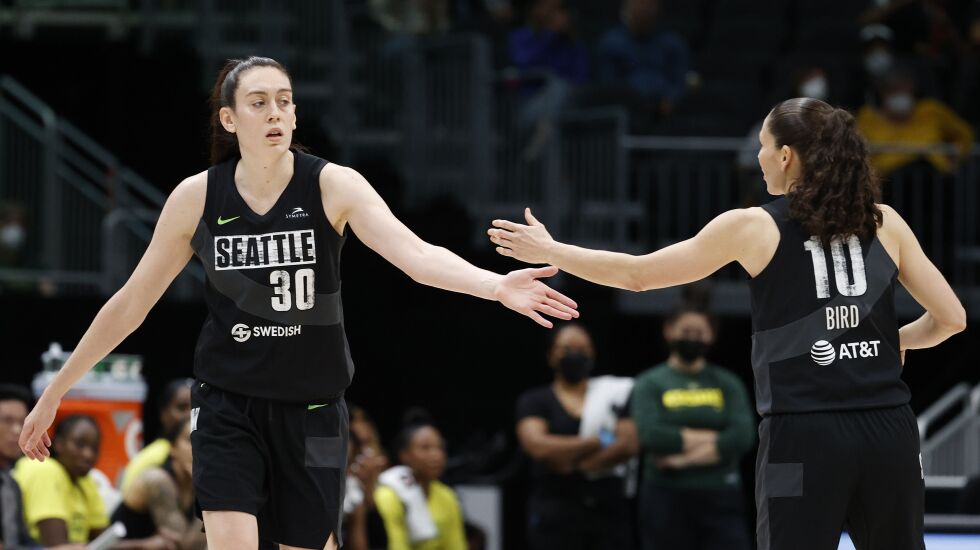
What does the WNBA need to see in the next couple of years? Bigger, better corporate partnerships. More lucrative media-rights deals. Major steps forward in merchandising and marketing. Along with all that, improvements in how players are compensated, treated and prioritized. In other words, all those things a league that too often has been overlooked can’t really thrive without.
In a sense, it’s same old, same old for the league, which marked its 25th anniversary in 2021. But the WNBA believes it has some momentum, with certain markets — Chicago being one of them — connecting encouragingly with the women’s game and many players eagerly using what seems to be, leaguewide, an expanding public platform.
“I actually think we have finally, in some ways, cracked the code a little bit,” said Seattle Storm guard Sue Bird, 41, who will play in her final All-Star Game on Sunday at Wintrust Arena. “I feel like now what we’ve done is kind of establish a foundation of who we are as a league, a foundation of how we want to market ourselves, the ways in which we want to represent ourselves. To me, it’s just about following the path that we’ve finally figured out.
“That’s really, I think, what’s going to push things forward, and, of course, to continue to put pressure on the powers that be. Because in my mind, [when] the TV deal is up in two years, that to me is the moment. . . . When they start negotiations for that, that could really break things open and change the entire trajectory of our league.”
WNBA commissioner Cathy Engelbert’s legacy could ride on the TV piece, and for obvious, frustrating reasons that Las Vegas Aces guard Kelsey Plum captured while describing what it’s often like when she’s asked by a potential viewer where to find a game.
“I’m like, ‘Well, you’ve got to download this app. Then you’ve got to put this in and, oh, it’s blacked out? So you’ve got to go to this place [instead],’ ’’ she said. “I would just like to see it be easier and more accessible to fans. We understand that the product is great and when we get people to watch the game, they love it, but the hardest part is getting people there.”
Meanwhile, the league is hoping to see its best players blow up into household names while also preparing to say goodbye to some of its brightest stars ever, who — like Bird — are getting ready to hang up the high-tops. The WNBA is at a critical crossroads, and Bird isn’t the only iconic player and champion who won’t be playing a leading role in seeing it through to the other side.
Bird has four titles and the league’s career assists lead under her belt. Center Sylvia Fowles, 36, spent the first half of her career with the Sky before winning it all twice and racking up the league’s career lead in rebounds with the Minnesota Lynx. Both can see the finish line.
“I think the foundation has been set with a lot of great players,” Fowles said. “Unfortunately, you’ve got to see some of those leave at this point, but I think we have a young group of talent that’s willing to do what needs to be done.”
Like Bird and Fowles, the Sky’s Candace Parker, 36, has won multiple titles and multiple Olympic gold medals and was ranked in the top 10 of ESPN’s all-time player rankings that marked the 25th anniversary season. Few, if any, have been more versatile than Parker on the court. Few, if any, have had a more recognizable face and name among sports fans on the whole. But Parker, too, might be gone after this season, when her contract with the Sky will expire. She’s in wait-and-see mode.
And we mustn’t forget Phoenix Mercury guard Diana Taurasi, 40, the No. 1 scorer in league history. Nobody has ever been better, and nobody has been harder to pin down about how long she’d like to keep playing. Taurasi says it’ll be awhile before it’s through, but it’s hard to envision a player so competitive being OK with losing too many steps.
The league soon will be in the hands of the Aces’ A’ja Wilson, 25, and the Storm’s Breanna Stewart, 27, if it isn’t already. They are the All-Star captains — and next-level talents — and Wilson scooped up Parker with the No. 1 pick in the draft of starters and reserves.
“Growing up, that was a role model of mine,” Wilson said. “She was someone that looked like me, that I could see, and it’s super dope. That’s why I took her No. 1, because I was like, ‘When am I going to have another opportunity to play with Candace Parker?’ ’’
Stewart has some marching orders already in her head.
“Making sure that, as we continue to strive for more in the WNBA and more for women, women in sports, that we’re honest with who we are and what we do,” she said. “And, at the same time, that we’re putting the league and [corporations] in uncomfortable positions that maybe they haven’t been in before — [but] where they need to get to — so then we can set the standard for something new.”







